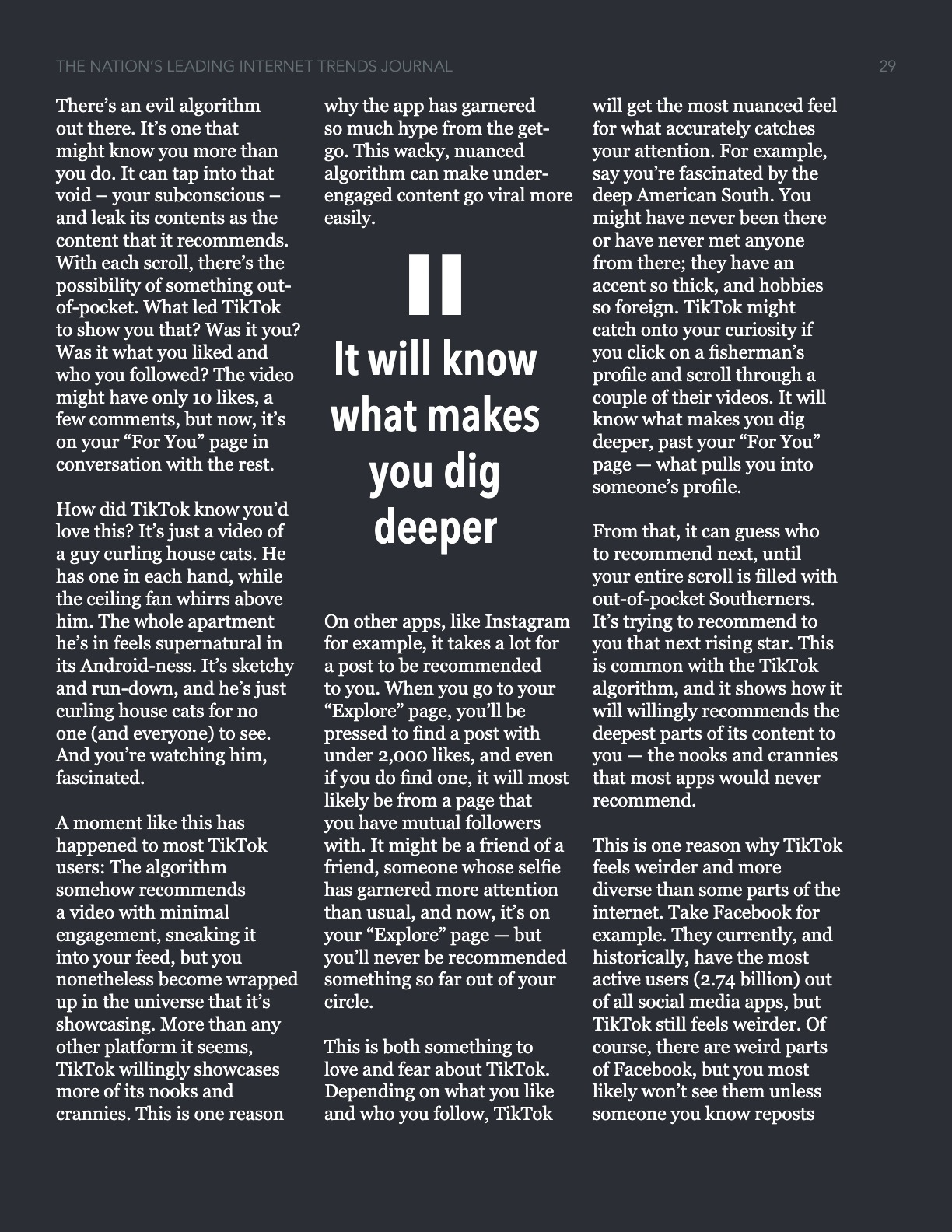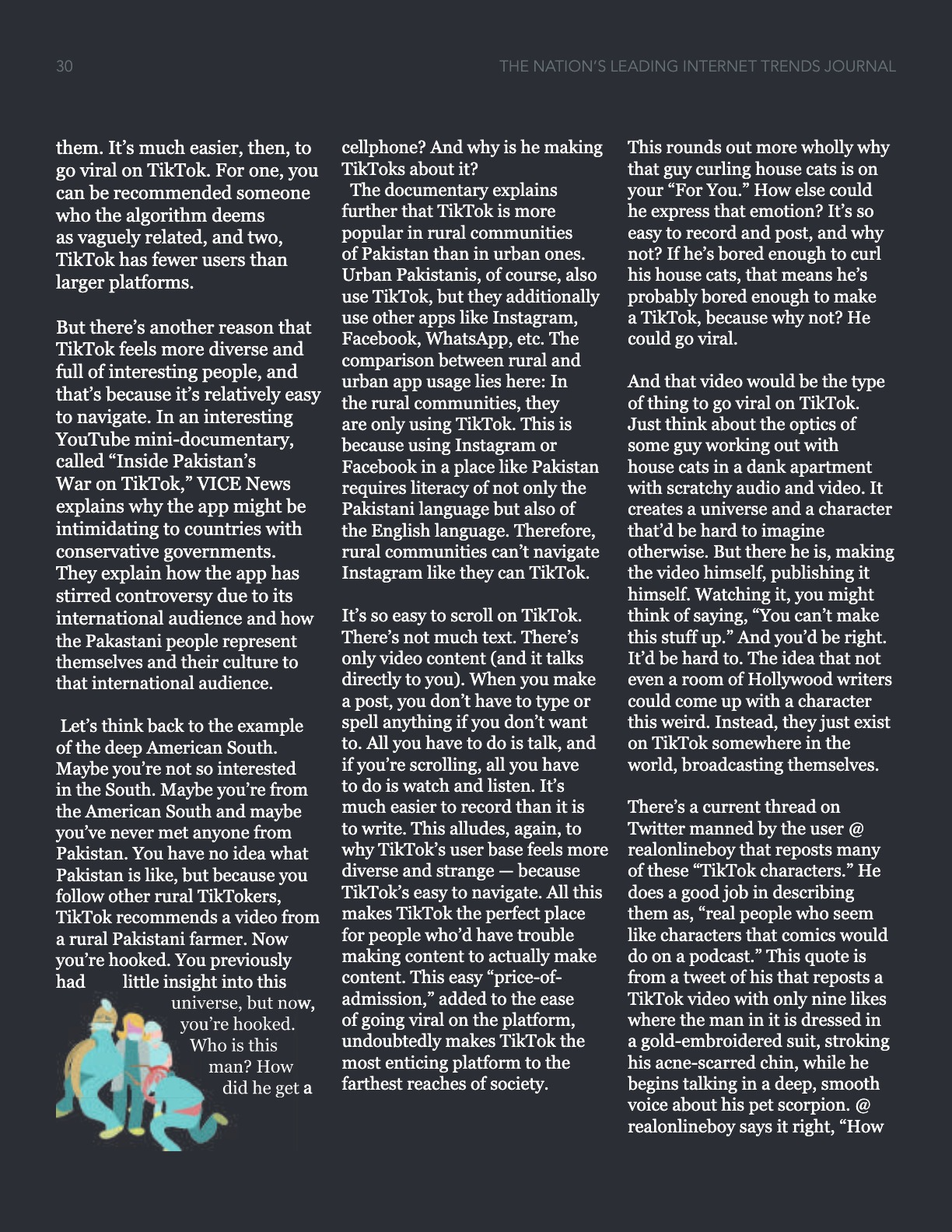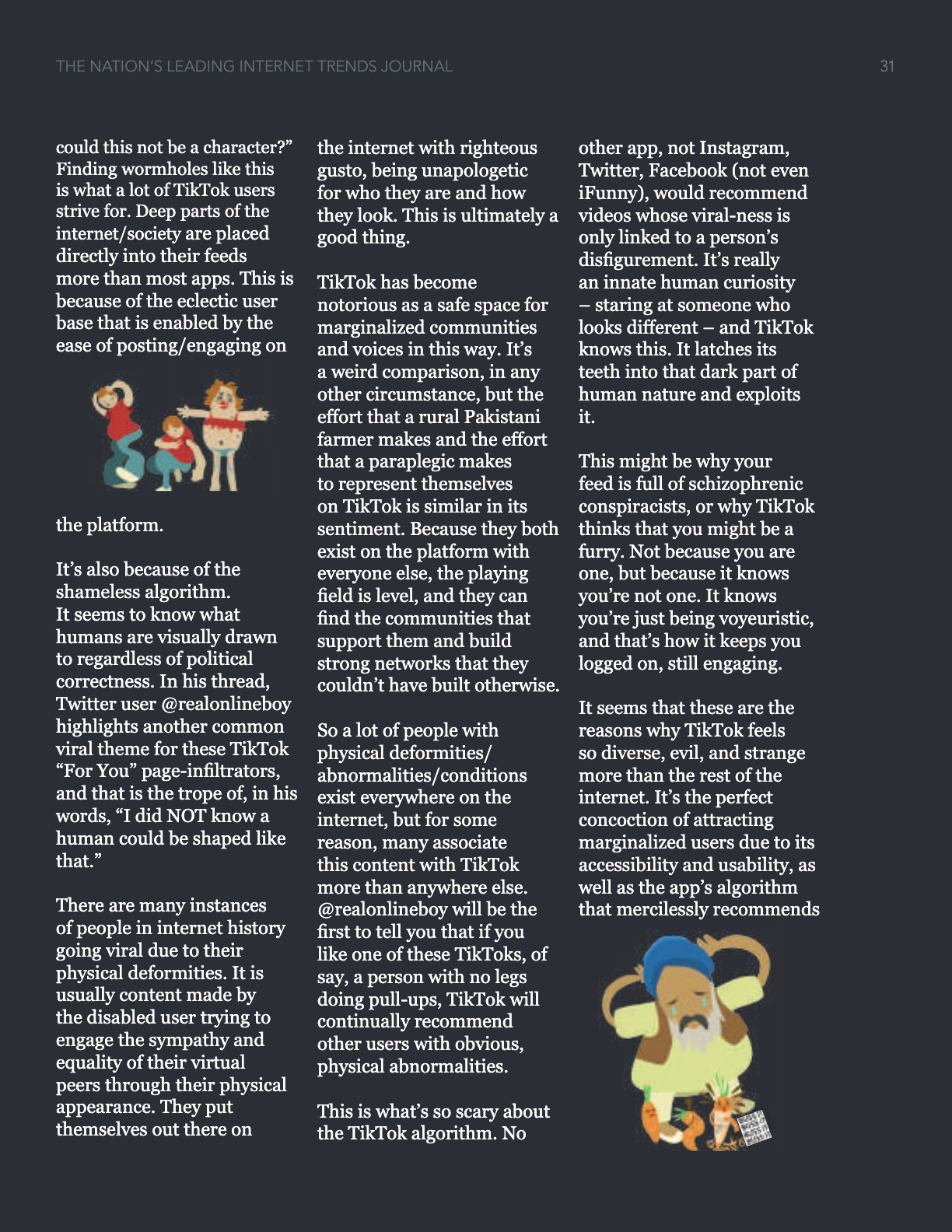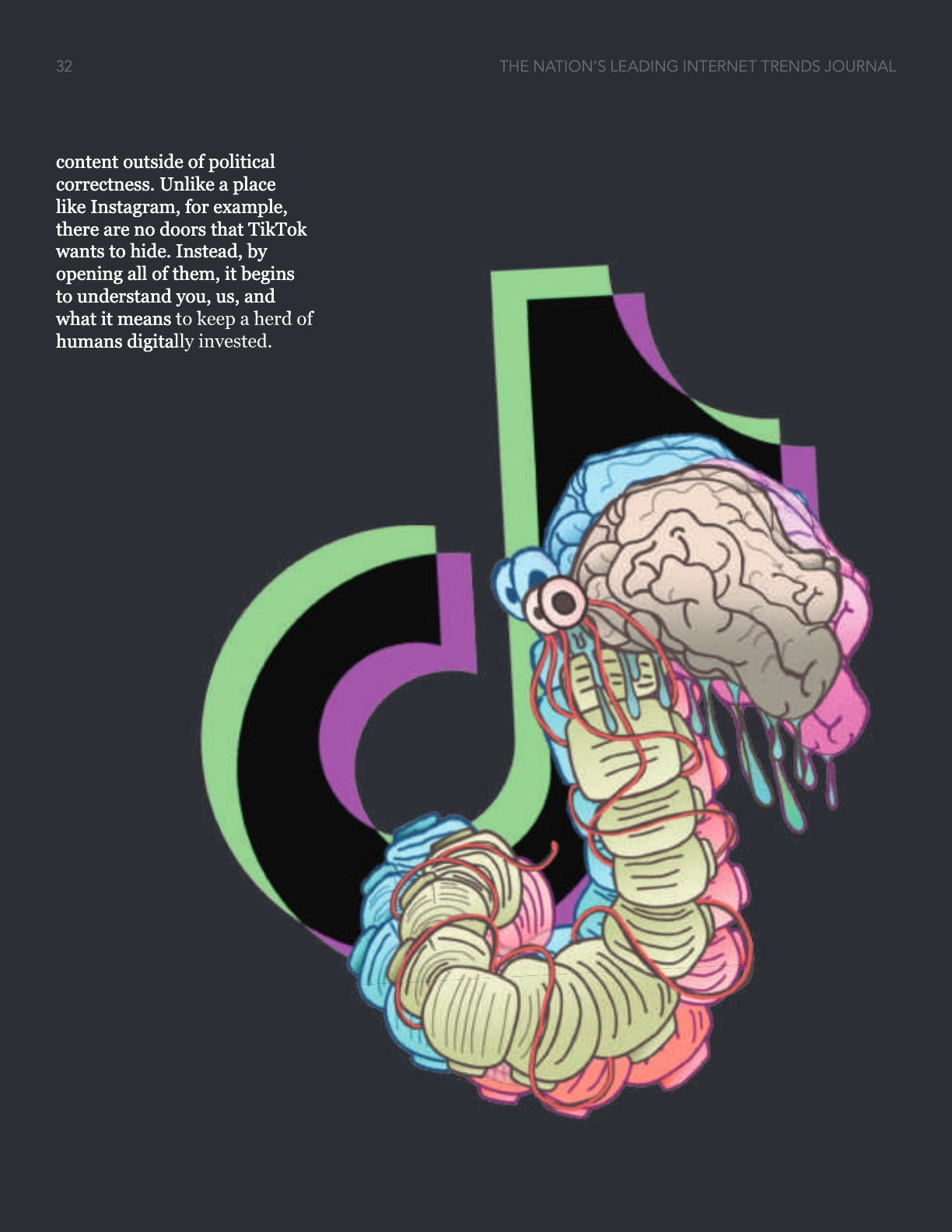TikTok Knows Your Little Secret
Why The Platform Sometimes Feels Like The Deepest Part Of The Internet

How did TikTok know you’d love this? It’s just a video of a guy curling house cats. He has one in each hand, while the ceiling fan whirrs above him. The whole apartment he’s in feels supernatural in its Android-ness. It’s sketchy and run-down, and he’s just curling house cats for no one (and everyone) to see. And you’re watching him, fascinated.
A moment like this has happened to most TikTok users: The algorithm somehow recommends a video with minimal engagement, sneaking it into your feed, but you nonetheless become wrapped up in the universe that it’s showcasing. More than any other platform it seems, TikTok willingly showcases more of its nooks and crannies. This is one reason why the app has garnered so much hype from the get-go. This wacky, nuanced algorithm can make under-engaged content go viral more easily.
On other apps, like Instagram for example, it takes a lot for a post to be recommended to you. When you go to your “Explore” page, you’ll be pressed to find a post with under 2,000 likes, and even if you do find one, it will most likely be from a page that you have mutual followers with. It might be a friend of a friend, someone whose selfie has garnered more attention than usual, and now, it’s on your “Explore” page — but you’ll never be recommended something so far out of your circle.
This is both something to love and fear about TikTok. Depending on what you like and who you follow, TikTok will get the most nuanced feel for what accurately catches your attention. For example, say you’re fascinated by the deep American South. You might have never been there or have never met anyone from there; they have an accent so thick, and hobbies so foreign. TikTok might catch onto your curiosity if you click on a fisherman’s profile and scroll through a couple of their videos. It will know what makes you dig deeper, past your “For You” page — what pulls you into someone’s profile.
From that, it can guess who to recommend next, until your entire scroll is filled with out-of-pocket Southerners. It’s trying to recommend to you that next rising star. This is common with the TikTok algorithm, and it shows how it will willingly recommends the deepest parts of its content to you — the nooks and crannies that most apps would never recommend.
This is one reason why TikTok feels weirder and more diverse than some parts of the internet. Take Facebook for example. They currently, and historically, have the most active users (2.74 billion) out of all social media apps, but TikTok still feels weirder. Of course, there are weird parts of Facebook, but you most likely won’t see them unless someone you know reposts them. It’s much easier, then, to go viral on TikTok. For one, you can be recommended someone who the algorithm deems as vaguely related, and two, TikTok has fewer users than larger platforms.
But there’s another reason that TikTok feels more diverse and full of interesting people, and that’s because it’s relatively easy to navigate. In an interesting YouTube mini-documentary, called “Inside Pakistan’s War on TikTok,” VICE News explains why the app might be intimidating to countries with conservative governments. They explain how the app has stirred controversy due to its international audience and how the Pakastani people represent themselves and their culture to that international audience.
Let’s think back to the example of the deep American South. Maybe you’re not so interested in the South. Maybe you’re from the American South and maybe you’ve never met anyone from Pakistan. You have no idea what Pakistan is like, but because you follow other rural TikTokers, TikTok recommends a video from a rural Pakistani farmer. Now you’re hooked. You previously had little insight into this universe, but now, you’re hooked. Who is this man? How did he get a cellphone? And why is he making TikToks about it?
The documentary explains further that TikTok is more popular in rural communities of Pakistan than in urban ones. Urban Pakistanis, of course, also use TikTok, but they additionally use other apps like Instagram, Facebook, WhatsApp, etc. The comparison between rural and urban app usage lies here: In the rural communities, they are only using TikTok. This is because using Instagram or Facebook in a place like Pakistan requires literacy of not only the Pakistani language but also of the English language. Therefore, rural communities can’t navigate Instagram like they can TikTok.
It’s so easy to scroll on TikTok. There’s not much text. There’s only video content (and it talks directly to you). When you make a post, you don’t have to type or spell anything if you don’t want to. All you have to do is talk, and if you’re scrolling, all you have to do is watch and listen. It’s much easier to record than it is to write. This alludes, again, to why TikTok’s user base feels more diverse and strange — because TikTok’s easy to navigate. All this makes TikTok the perfect place for people who’d have trouble making content to actually make content. This easy “price-of-admission,” added to the ease of going viral on the platform, undoubtedly makes TikTok the most enticing platform to the farthest reaches of society.
This rounds out more wholly why that guy curling house cats is on your “For You.” How else could he express that emotion? It’s so easy to record and post, and why not? If he’s bored enough to curl his house cats, that means he’s probably bored enough to make a TikTok, because why not? He could go viral.
And that video would be the type of thing to go viral on TikTok. Just think about the optics of some guy working out with house cats in a dank apartment with scratchy audio and video. It creates a universe and a character that’d be hard to imagine otherwise. But there he is, making the video himself, publishing it himself. Watching it, you might think of saying, “You can’t make this stuff up.” And you’d be right. It’d be hard to. The idea that not even a room of Hollywood writers could come up with a character this weird. Instead, they just exist on TikTok somewhere in the world, broadcasting themselves.
There’s a current thread on Twitter manned by the user @realonlineboy that reposts many of these “TikTok characters.” He does a good job in describing them as, “real people who seem like characters that comics would do on a podcast.” This quote is from a tweet of his that reposts a TikTok video with only nine likes where the man in it is dressed in a gold-embroidered suit, stroking his acne-scarred chin, while he begins talking in a deep, smooth voice about his pet scorpion. @realonlineboy says it right, “How could this not be a character?” Finding wormholes like this is what a lot of TikTok users strive for. Deep parts of the internet/society are placed directly into their feeds more than most apps. This is because of the eclectic user base that is enabled by the ease of posting/engaging on the platform.
It’s also because of the shameless algorithm. It seems to know what humans are visually drawn to regardless of political correctness. In his thread, Twitter user @realonlineboy highlights another common viral theme for these TikTok “For You” page-infiltrators, and that is the trope of, in his words, “I did NOT know a human could be shaped like that.”
There are many instances of people in internet history going viral due to their physical deformities. It is usually content made by the disabled user trying to engage the sympathy and equality of their virtual peers through their physical appearance. They put themselves out there on the internet with righteous gusto, being unapologetic for who they are and how they look. This is ultimately a good thing.
TikTok has become notorious as a safe space for marginalized communities and voices in this way. It’s a weird comparison, in any other circumstance, but the effort that a rural Pakistani farmer makes and the effort that a paraplegic makes to represent themselves on TikTok is similar in its sentiment. Because they both exist on the platform with everyone else, the playing field is level, and they can find the communities that support them and build strong networks that they couldn’t have built otherwise.
So a lot of people with physical deformities/abnormalities/conditions exist everywhere on the internet, but for some reason, many associate this content with TikTok more than anywhere else. @realonlineboy will be the first to tell you that if you like one of these TikToks, of say, a person with no legs doing pull-ups, TikTok will continually recommend other users with obvious, physical abnormalities.
This is what’s so scary about the TikTok algorithm. No other app, not Instagram, Twitter, Facebook (not even iFunny), would recommend videos whose viral-ness is only linked to a person’s disfigurement. It’s really an innate human curiosity – staring at someone who looks different – and TikTok knows this. It latches its teeth into that dark part of human nature and exploits it.
This might be why your feed is full of schizophrenic conspiracists, or why TikTok thinks that you might be a furry. Not because you are one, but because it knows you’re not one. It knows you’re just being voyeuristic, and that’s how it keeps you logged on, still engaging.
It seems that these are the reasons why TikTok feels so diverse, evil, and strange more than the rest of the internet. It’s the perfect concoction of attracting marginalized users due to its accessibility and usability, as well as the app’s algorithm that mercilessly recommends content outside of political correctness. Unlike a place like Instagram, for example, there are no doors that TikTok wants to hide. Instead, by opening all of them, it begins to understand you, us, and what it means to keep a herd of humans digitally invested.
click here to read this article in the August 2021 Meme Insider issue.





©owencarry.com